Women of the Bible typically conjure up images of the famous founding matriarchs — key figures like Sarah and Leah and Rebecca and Rachel. But what of the less widely known women who played significant roles in their own way? Women like Taphath and Basemath, daughters of Solomon, chosen to marry important men in order to report back to their father; or Delilah, bribed by the lords of the Philistines to help discover the source of Samson’s strength?
While many women of the Bible are rarely mentioned by name (and the ones who are only make up 5.5 to 8 percent of the text,) Israeli photographer Dikla Laor tells NoCamels she wants to make sure all of the females of the holy book have their time in the spotlight.
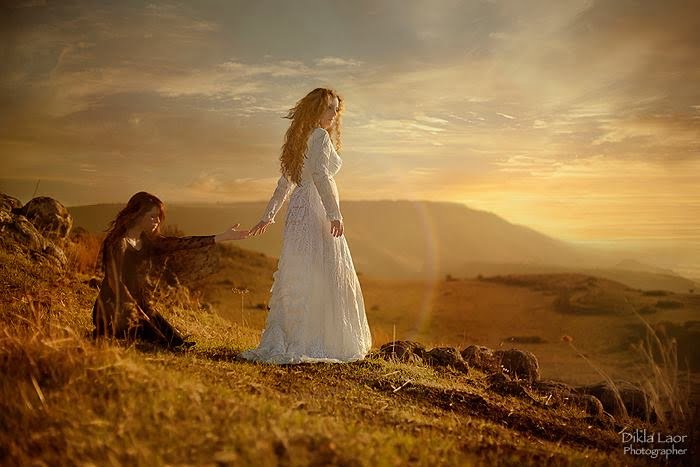
“Refrain thy voice from weeping, and thine eyes from tears.” Jeremiah 31;15
“Some people say that the Bible doesn’t give enough place to the women, that most of the stories are about the men. The men are the kings,” Laor explains, “I actually see it differently. Even though the women have small parts or don’t have much text to describe them, you will see that what they say and what they do affects the future, affects the kings, affects us.”
With a digital camera and the backdrop of the stunning Golan Heights landscape, Laor is on a mission to prove it. Since 2013, Laor has created intricately staged photographs featuring every single woman from the Hebrew Bible. She jokingly admits to NoCamels that the project, which has already spanned seven years, will take her a “lifetime” as she continues to create photos showcasing the 200 women highlighted in the text.
She’s off to a good start.
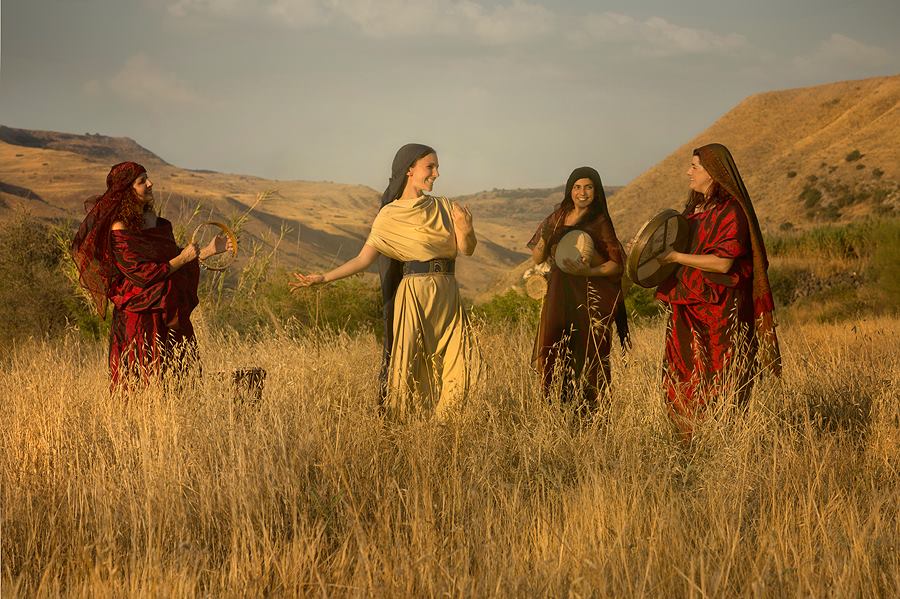
“And Dina the daughter of Leah, whom she had borne onto Jacob, went out to see the daughters of the land.” Genesis 4 34
Moren than 81 characters will be featured in two thick tomes filled with eye-catching photographs documenting Laor’s interpretation of those women in dress, appearance, and behavior. The first book, “Women in the Bible on the Golan Landscape”, has 41 striking photographs including Eve, Sarah, Rebecca, Leah, and Rachel, as well as the lesser-known but still recognizable names like Miriam, Abigail, Dina, Ruth, and the Queen of Sheba.
The second book, which is not yet published, and which has only 20 photos to its credit so far, will have even less familiar names like Egyptian queen Taphenes, and Shaharaim’s wives Hushim, Baara, and Hodesh. There is no doubt that for Laor, these less recognizable names are just as notable.
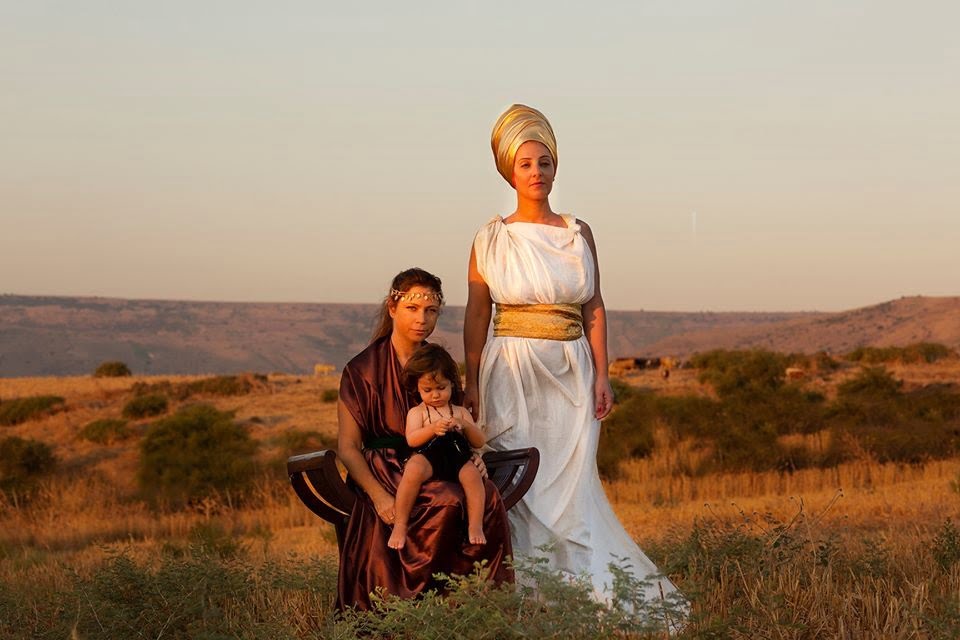
“And the sister of Tahpenes bore him Genubath his son, who Tahpenes weaned in Pharoah’s house; and Genubath was in Pharoah’s house among the sons of Pharoah.” Kings A 11, 20
Women of the Bible
The first book was published in April 2019 to much acclaim — copies have sold out across the world, Laor says — which spurred the Israeli photographer to continue her quest. The newer photos, some with multiple women in one frame, will be part of her second book, which she aims to complete in two years, rather than six.
Laor says she did not anticipate the immense popularity of her first book, which has buyers from across the globe. Due to the first book’s international acclaim, the second book will be in English orientation, meaning left to right (with Hebrew translation.
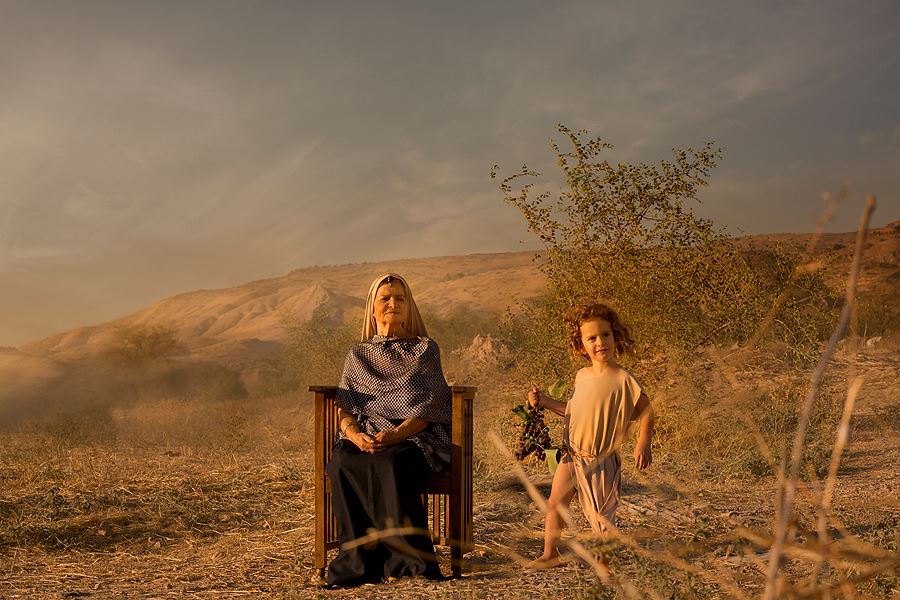
“And she said Who would have said unto Abraham, that Sarah could give children suck? for I have borne him a child in his old age.” Genesis 21, 7
For all of her photographs, Laor styles the photoshoots herself, working with real women, not models, and choosing the fabrics and colors of their dress carefully. Most of the women she chose were friends, and some were family members. Sarah and Isaac were played by her mother and young son. Adding extra significance to the photo is the 130-year old cloth worn by Laor’s mother, which she said belonged to her grandfather in Tunis.
Laor herself took on the role of Hanna, Samuel’s mother, clad in blue which she says is for purity.
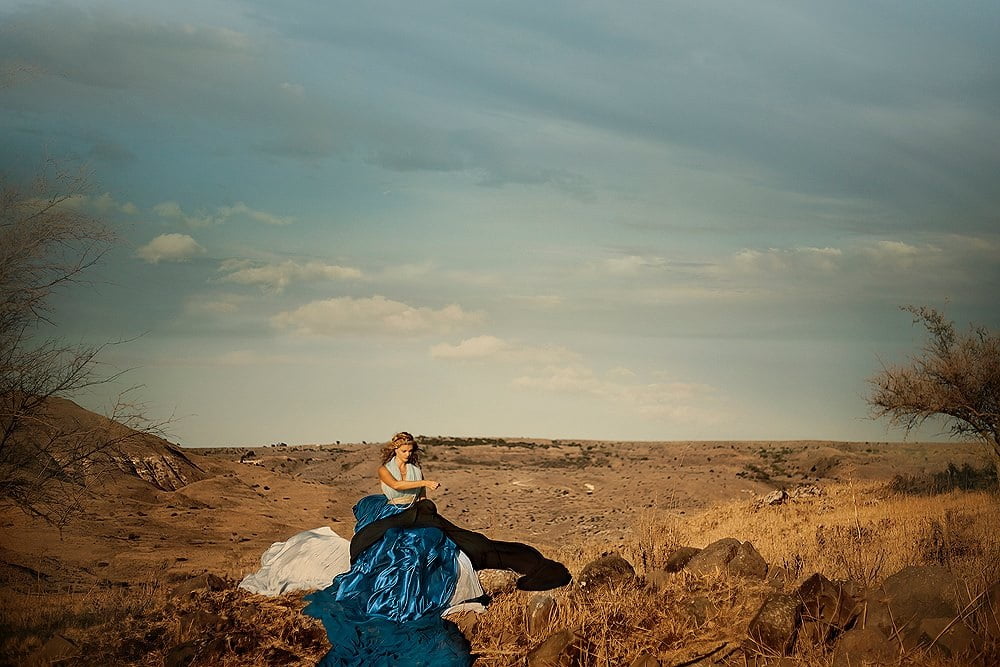
״Moreover his mother made him a little robe, and brought it to him from year to year, when she came up with her husband to offer the yearly sacrifice.״ Samuel 1:2;19
In the picture, Laor, as Hanna, is sewing a robe for her son, which is the story from the Bible. “Why did I choose to mention that she is sewing his coat? Anytime that Shmuel (Samuel) is mentioned, he’s always wearing a coat,” she says, “And when he died, and the witch brought his soul before the king, she tells him, ‘I’m seeing an old man with a coat.’ That’s how you knew it was him. What it means is that his mom’s influence was so strong, that it was with him his whole life and even after his death.”
Setting the scene for Biblical art
Laor has lived in the Golan Heights since 2005 and shoots her photographs there because she says its unique and diverse setting, including mountains that change with the season, dried earth in the summer, and green in the winter, give her a lot of variety to showcase as the background of her work.
Sign up for our free weekly newsletter
Subscribe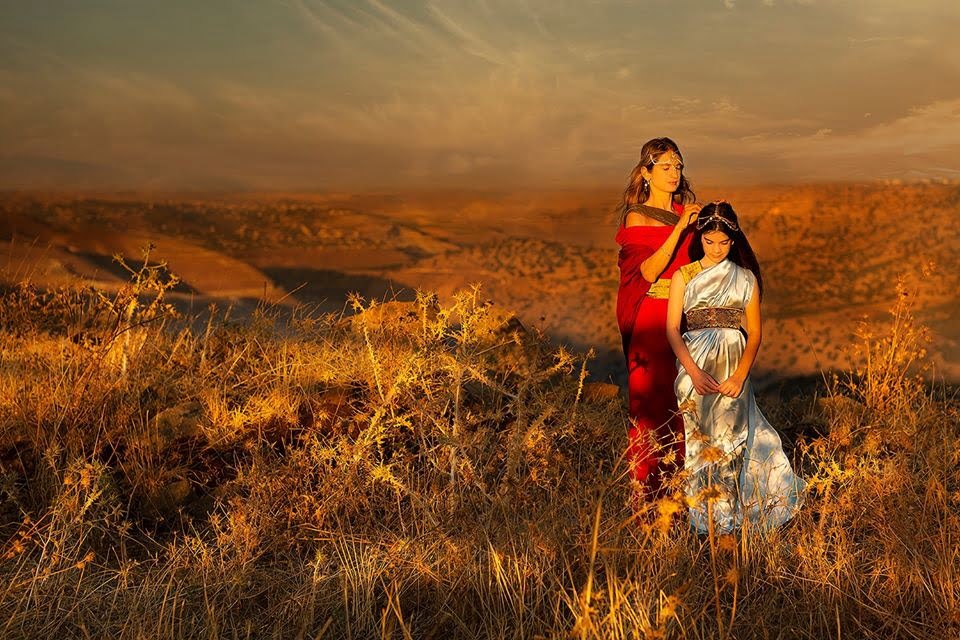
“The son of Abinadab, in all the region of Dor; he had Taphath, the daughter of Solomon to wife…Ahimaaz, in Naphtali; he also took Basemath, the daughter of Solomon to wife,” king 1, 4, 11, 15
While she knows exactly what she wants out of the picture, including what the model will look like, what she will wear, and what she will be doing, Laor says she often has to wait for the right time in the season, to capture the right moment.
SEE ALSO: Israeli Photographer Brings Female Biblical Figures To Life With Magnificent Images
“Eighty percent of the pictures are being taken in the south of the Golan Heights, where I live,” she says. “These are archeological places, and natural places — not many pictures are taken at water sites. I usually take the pictures where it’s yellow and dry. Unless I want to say something that means procreation and giving birth and new life. That’s where I’m going to take the pictures in the winter when it’s green.”
Laor decided she would use her second book to focus on more of the unknown stories from the Hebrew Bible, featuring women — what she calls “characters from the back of the Bible.”
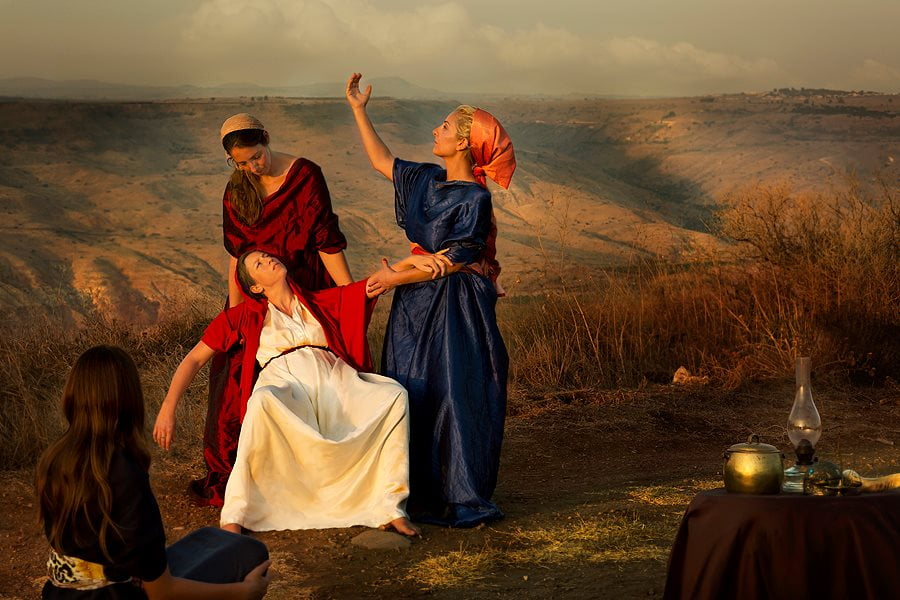
“And his daughter-in-law, Phinehas’ wife, was with child, near to be delivered; and when she heard the tidings, that the ark of God was taken, and that her husband and father-in-law were dead, she bowed herself and brought forth; for her pains suddenly came upon her.” Shmuel 1 4 19
While most people know the story of Noah’s Ark and the flood that occurs in Genesis, fewer know about the wives of the sons of Noah. They are named in the Hebrew Bible (Old Testament), and Laor sees them as part of the rebirth of a new world.
“The cover of my first book was Eve. Because she is the mother of all humankind. After the flood, all of humanity died. So the wives of his sons are the Eves of the new generation.”
Laor showcased this by clothing the wives in green to represent birth and new life.

‘Go forth from the ark, thou, and thy wives, and thy sons, and thy sons’ wives with thee…and be fruitful and multiply upon the earth.’ Genesis, 8, 16-17
Laor says the last picture she shot (prior to publication of this article,) was the picture of Manoah’s wife, an unnamed figure in the Book of Judges who becomes Samson’s mother. A barren woman, according to the story, an angel appears to reveal her pregnancy.
The photo is very special to Laor because she was the one to make the wings of the angel featured in the photograph. She created them based on a frame of cardboard, iron, and foam. When the frame was ready, she covered the entire surface with feathers and furry fabrics and then painted it in shades of black and brown.
In Laor’s interpretation, Manoah’s wife is dressed in dramatic colors of red and blue, which she explains is meant to make her look similar to Mary, the mother of Yeshua (Jesus). According to the story, Manoah’s wife conceived Samson through the angel.
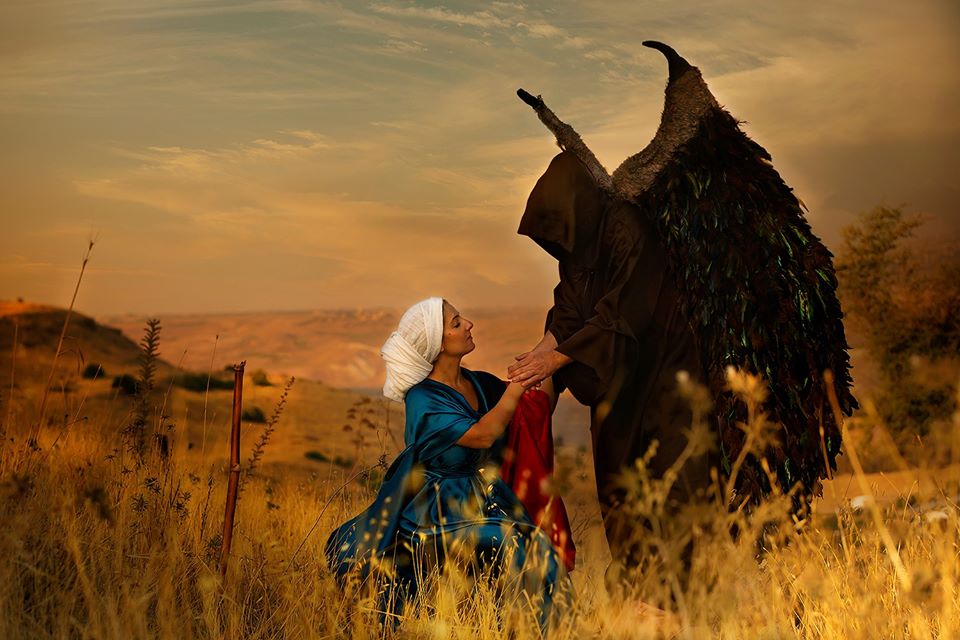
“and the angel of God came again unto the woman as she sat int he field; but Manoah her husband was not with her.” Judges 13, 9
“That’s why I chose to dress her like Mary, to say that she was giving birth from God,” Laor says.
“When you see the image for the first time, sometimes you judge it technically. But as long as you see it and go learn about the stories, you will discover new things about the picture. Why did I make this decision? Nothing about it is spontaneous. With every picture, there is something to tell,” she tells NoCamels.
Related posts

Rehabilitation Nation: Israeli Innovation On Road To Healing

Israeli High-Tech Sector 'Still Good' Despite Year Of War




Facebook comments